Deck 14: Section 8: Multiple Integration
Question
Question
Question
Question
Question
Question
Question
Question
Question
Question
Question
Question
Question
Question
Question
Question
Question
Question
Question

Unlock Deck
Sign up to unlock the cards in this deck!
Unlock Deck
Unlock Deck
1/19
Play
Full screen (f)
Deck 14: Section 8: Multiple Integration
1
Sketch the image S in the uv-plane of the region R in the xy-plane using the given transformation. 
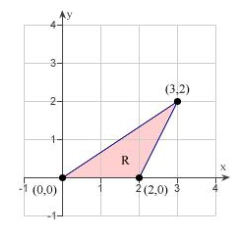
A)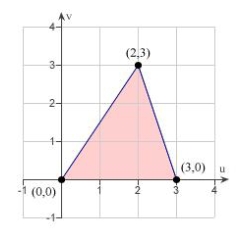
B)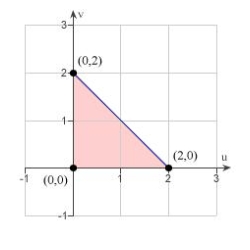
C)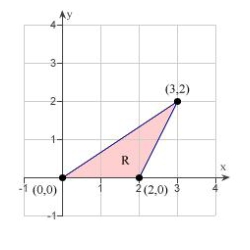
D)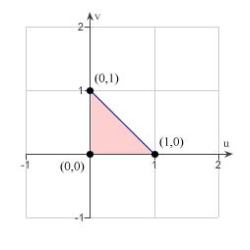
E)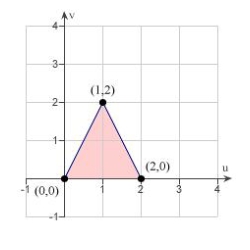


A)

B)

C)

D)

E)


2
If  and
and  then the Jacobian of x, y, and z with respect to u, v, and w is
then the Jacobian of x, y, and z with respect to u, v, and w is 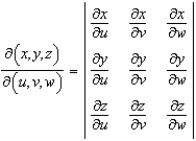 .
.
Find the Jacobian for the following change of variables:
A)
B)
C)
D)
E)
 and
and  then the Jacobian of x, y, and z with respect to u, v, and w is
then the Jacobian of x, y, and z with respect to u, v, and w is  .
.Find the Jacobian for the following change of variables:

A)

B)

C)

D)

E)


3
Find the Jacobian for the change of variables given below. 
A)
B)
C)
D)
E)

A)

B)

C)

D)

E)


4
Use a change of variables to find the volume of the solid region lying below the surface  and above the plane region R: region bounded by the square with vertices
and above the plane region R: region bounded by the square with vertices  .
.
A)
B)
C)
D)
E)
 and above the plane region R: region bounded by the square with vertices
and above the plane region R: region bounded by the square with vertices  .
.A)

B)

C)

D)

E)


Unlock Deck
Unlock for access to all 19 flashcards in this deck.
Unlock Deck
k this deck
5
Use a change of variables to find the volume of the solid region lying below the surface  and above the plane region R: region bounded by the parallelogram with vertices
and above the plane region R: region bounded by the parallelogram with vertices  . Round your answer to two decimal places.
. Round your answer to two decimal places.
A)
B)
C)
D)
E)
 and above the plane region R: region bounded by the parallelogram with vertices
and above the plane region R: region bounded by the parallelogram with vertices  . Round your answer to two decimal places.
. Round your answer to two decimal places.A)

B)

C)

D)

E)


Unlock Deck
Unlock for access to all 19 flashcards in this deck.
Unlock Deck
k this deck
6
Use a change of variables to find the volume of the solid region lying below the surface  and above the plane region R: region bounded by the graphs of
and above the plane region R: region bounded by the graphs of  (Hint: Let
(Hint: Let  .) Round your answer to two decimal places.
.) Round your answer to two decimal places.
A)
B)
C)
D)
E)
 and above the plane region R: region bounded by the graphs of
and above the plane region R: region bounded by the graphs of  (Hint: Let
(Hint: Let  .) Round your answer to two decimal places.
.) Round your answer to two decimal places.A)

B)

C)

D)

E)


Unlock Deck
Unlock for access to all 19 flashcards in this deck.
Unlock Deck
k this deck
7
Find the Jacobian for the indicated change of variables. 
A)
B)
C)
D)
E)

A)

B)

C)

D)

E)


Unlock Deck
Unlock for access to all 19 flashcards in this deck.
Unlock Deck
k this deck
8
Consider the region  in the xy-plane bounded by the ellipse
in the xy-plane bounded by the ellipse  and the transformation
and the transformation  and
and  . Find
. Find  .
.
A)
B)
C)
D)
E)
 in the xy-plane bounded by the ellipse
in the xy-plane bounded by the ellipse  and the transformation
and the transformation  and
and  . Find
. Find  .
.A)

B)

C)

D)

E)


Unlock Deck
Unlock for access to all 19 flashcards in this deck.
Unlock Deck
k this deck
9
Find the Jacobian  for the following change of variables:
for the following change of variables: 
A)
B)
C)
D)
E)
 for the following change of variables:
for the following change of variables: 
A)

B)

C)

D)

E)


Unlock Deck
Unlock for access to all 19 flashcards in this deck.
Unlock Deck
k this deck
10
Use a change of variables to find the volume of the solid region lying below the surface  and above the plane region R: region bounded by the parallelogram with vertices
and above the plane region R: region bounded by the parallelogram with vertices  . Round your answer to two decimal places.
. Round your answer to two decimal places.
A)
B)
C)
D)
E)
 and above the plane region R: region bounded by the parallelogram with vertices
and above the plane region R: region bounded by the parallelogram with vertices  . Round your answer to two decimal places.
. Round your answer to two decimal places.A)

B)

C)

D)

E)


Unlock Deck
Unlock for access to all 19 flashcards in this deck.
Unlock Deck
k this deck
11
If  and
and  then the Jacobian of x, y, and z with respect to u, v, and w is
then the Jacobian of x, y, and z with respect to u, v, and w is 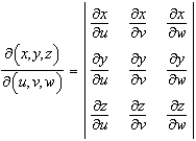 . Find the Jacobian for the following change of variables:
. Find the Jacobian for the following change of variables: 
A)
B)
C)
D)
E)
 and
and  then the Jacobian of x, y, and z with respect to u, v, and w is
then the Jacobian of x, y, and z with respect to u, v, and w is  . Find the Jacobian for the following change of variables:
. Find the Jacobian for the following change of variables: 
A)

B)

C)

D)

E)


Unlock Deck
Unlock for access to all 19 flashcards in this deck.
Unlock Deck
k this deck
12
Use the indicated change of variables to evaluate the following double integral. 
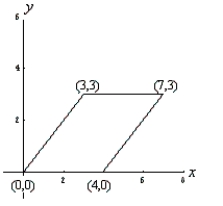
A)
B)
C)
D)
E)


A)

B)

C)

D)

E)


Unlock Deck
Unlock for access to all 19 flashcards in this deck.
Unlock Deck
k this deck
13
Find the Jacobian  for the following change of variables:
for the following change of variables: 
A)
B)
C)
D)
E)
 for the following change of variables:
for the following change of variables: 
A)

B)

C)

D)

E)


Unlock Deck
Unlock for access to all 19 flashcards in this deck.
Unlock Deck
k this deck
14
Use the indicated change of variables to evaluate the following double integral. 
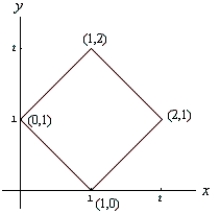
A)
B)
C)
D)
E)


A)

B)

C)

D)

E)


Unlock Deck
Unlock for access to all 19 flashcards in this deck.
Unlock Deck
k this deck
15
Use the following change of variables to evaluate the double integral  . Round your answer to four decimal places.
. Round your answer to four decimal places. 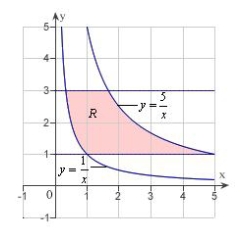

A)
B)
C)
D)
E)
 . Round your answer to four decimal places.
. Round your answer to four decimal places. 

A)

B)

C)

D)

E)


Unlock Deck
Unlock for access to all 19 flashcards in this deck.
Unlock Deck
k this deck
16
Find a transformation  that when applied to region
that when applied to region  , its image will be
, its image will be  .
. 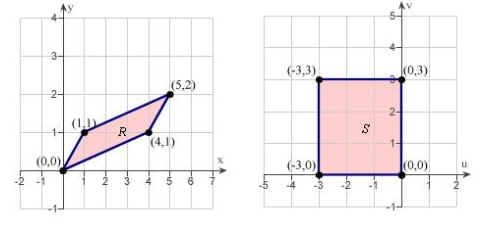
A)
B)
C)
D)
E)
 that when applied to region
that when applied to region  , its image will be
, its image will be  .
. 
A)

B)

C)

D)

E)


Unlock Deck
Unlock for access to all 19 flashcards in this deck.
Unlock Deck
k this deck
17
Consider the region R in the xy-plane bounded by the ellipse  and the transformation
and the transformation  and
and  . Find the area of the ellipse. Round your answer to two decimal places.
. Find the area of the ellipse. Round your answer to two decimal places.
A)
B)
C)
D)
E)
 and the transformation
and the transformation  and
and  . Find the area of the ellipse. Round your answer to two decimal places.
. Find the area of the ellipse. Round your answer to two decimal places.A)

B)

C)

D)

E)


Unlock Deck
Unlock for access to all 19 flashcards in this deck.
Unlock Deck
k this deck
18
Find the Jacobian  for the following change of variables:
for the following change of variables: 
A)
B)
C)
D)
E)
 for the following change of variables:
for the following change of variables: 
A)

B)

C)

D)

E)


Unlock Deck
Unlock for access to all 19 flashcards in this deck.
Unlock Deck
k this deck
19
Use a change of variables to find the volume of the solid region lying below the surface  and above the plane region R.
and above the plane region R.  R: region bounded by the triangle with vertices
R: region bounded by the triangle with vertices 
A)
B)
C)
D)
E)
 and above the plane region R.
and above the plane region R.  R: region bounded by the triangle with vertices
R: region bounded by the triangle with vertices 
A)

B)

C)

D)

E)


Unlock Deck
Unlock for access to all 19 flashcards in this deck.
Unlock Deck
k this deck



